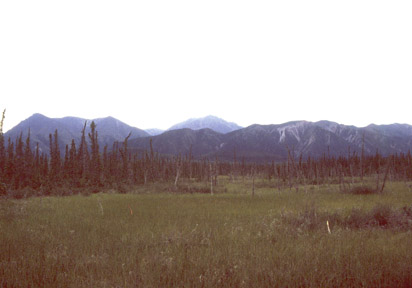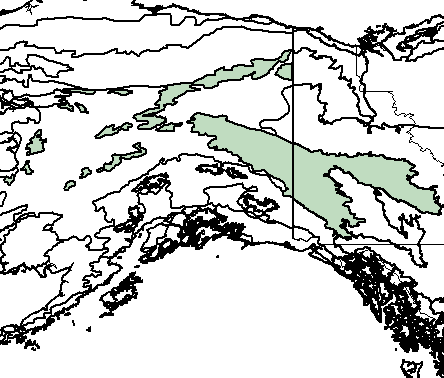
Black spruce and tundra near Beaver Creek, Yukon Territory (c) 2005 Scott and Ruth Bassett
Bioimages home (click on an image to enlarge)
view
this page in its intended navigation context
Interior Yukon/Alaska alpine tundra
(WWF
ecoregion NA1111)

Black spruce and tundra near Beaver Creek, Yukon Territory
(c)
2005 Scott and
Ruth Bassett

Source of bioregions data:
Olson, D. M. and
E. Dinerstein. The Global 200: Priority ecoregions for global conservation. (PDF
file) Annals of the Missouri Botanical Garden 89:125-126.
Distinctiveness (1=highest,4=lowest): 2 (regionally
outstanding)
This ecoregion contains a variety of large mammals and predators.*
Conservation Status (1=most endangered, 5=most
intact): 4 (relatively stable)
About 85% of this ecoregion remains intact. Mining and road development are the
main disturbances.*
 Picea glauca (white spruce)
Picea glauca (white spruce) Picea mariana (black spruce)
Picea mariana (black spruce) | Populus tremuloides | (quaking aspen) |
Salix spp. (dwarf willows)
 |
Pinus contorta | (lodgepole pine) |
 | Abies lasiocarpa | (subalpine fir) |
Dryas hookeriana (mountain avens)
Associated habitats
Black spruce, near Beaver Creek, Yukon Territory

(c)
2005 Scott and
Ruth Bassett
hires
Tundra, south of the Brooks Range, Alaska



center: Stunted trees along the Dalton Hwy. approaching the southern foothills
of the Brooks Range (note elevated pipeline at left) right: Undulations caused
by movement of the permafrost below the tundra.
(c)
2005 Scott and
Ruth Bassett
hires
hires
hires
Willows, near the Arctic Circle, Alaska


(c)
2005 Scott and
Ruth Bassett
hires
hires
Black spruce and caribou, near Mancha Creek, Arctic National Wildlife Refuge, Alaska


(c) 2006
Dallas Smith
hires
hires
* Ricketts, T.H., E. Dinerstein, D.M. Olson, C.J. Loucks, et al. (1999) Terrestrial Ecoregions of North America: A Conservation Assessment. World Wildlife Fund - United States and Canada. Island Press, Washington, D.C. pp. 390-392.
Except as noted, images copyright 2002-2005 Steve Baskauf - Terms of use